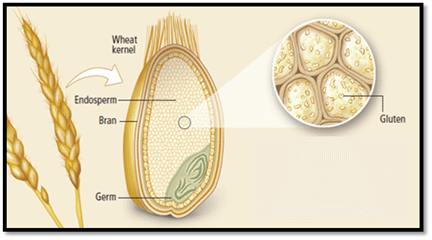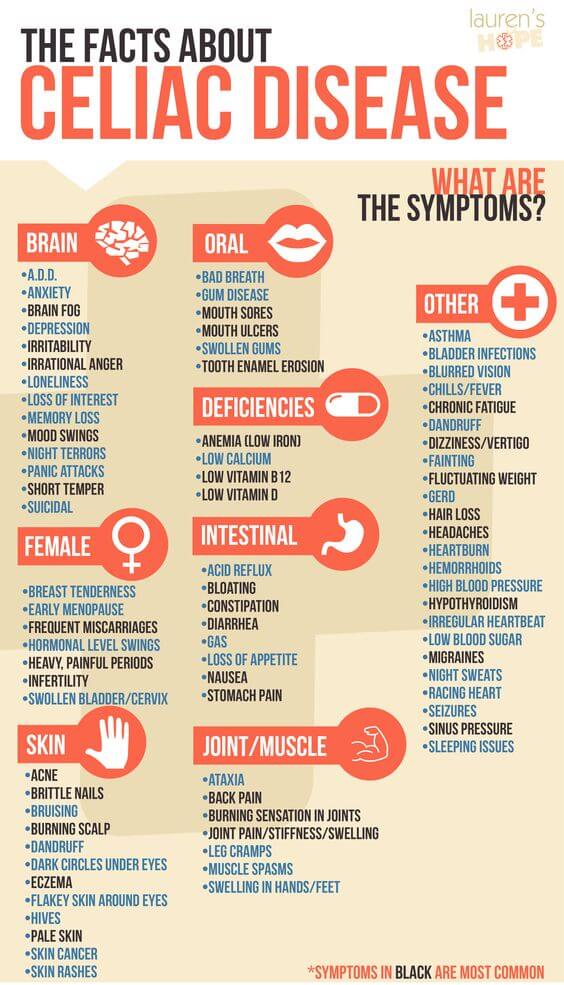- Celiac disease affects about 1% of the world population.
- If you do not treat celiac by simply avoiding foods that contain gluten, it can cause damage to other organs in the body.
- People with celiac can’t eat foods that contain the wheat protein called gluten.
- The only treatment as of today is simply not eating foods containing gluten.
Celiac disease for dummies is a page dedicated to provide info on celiac disease without using complicated and medical language so that the common person can understand and learn.
*Please note though that we are not medical professions, and this post was not written by doctors. All the info found here is gathered from the Internet and can be found by anyone.
Celiac disease is an autoimmune disorder that, unfortunately, affects 1 in 100 people worldwide.
For people who suffer from celiac disease, consuming gluten results in severe damages to the small intestine, leading to the body’s inability to absorb nutrients properly.
If it is left untreated or it is treated improperly, celiac disease can damage other organs and cause long-term health complications.
Fortunately, a well-informed and careful celiac person can lead a perfectly normal life and keep unpleasant reactions and complications at bay.
The main goal of this article is to offer you valuable information on the most common symptoms of the disease, how to proceed if you suspect you might suffer from it, and tips on how to follow a gluten-free diet and live healthily.
Celiac Disease for Dummies – What is gluten?

In simple terms, gluten is a protein found in certain grains such as wheat, spelt, rye, or barley. However, of all the gluten-containing grains, wheat is the most frequently consumed worldwide.
Gluten is present in numerous food items, sometimes clearly displayed on the labels and some other well hidden in the ingredients.
While reading the labels and knowing the type of ingredients to avoid might save celiac people from problems, gluten might be the invisible foe – sometimes really difficult to detect – in certain products and items such as:
- Play-dough
- Glue (including the glue on stamps and envelopes)
- Personal care items (lipsticks, shampoo, etc.)
- Chewing gum
- Drugs and vitamin supplements
- Cooking utensils
- Restaurant food (due to cross-contamination)
- Products labeled as ‘Wheat-free’ (wheat is not the only gluten-containing grain, hence wheat-free is not a synonym of gluten-free!)
- Condiments
- Toothpaste and mouthwash
- Modified food starch, stabilizers, and preservatives
- Candy
- Communion wafers
- Instant and flavored coffee
Celiac Disease – The most common symptoms
Celiac disease is not age-related. That means that, once people start consuming gluten-containing foods, the disease can develop anytime, including in infants.
Though symptoms can vary in nature and intensity, some are more recurrent than others. If you experience one or several of the following symptoms regularly, you should consider undergoing screening for celiac disease:
- Gastrointestinal disorders (diarrhea, constipation)
- Bloating
- Heartburn, reflux
- Unexpected weight loss/gain
- Itchy blisters on knees, elbows, buttocks (more rarely on the back, shoulders, or face)
- Pale stools that stick to the toilet bowl
- In children, failure to develop and grow normally
Here is an infographic showing some of the less common symptoms of celiac disease

While the digestive symptoms are the most common ones, some people may have symptoms such as anemia, tiredness, or even depression. Neurologic symptoms such as seizures, tingling feet, legs, or hands, numbness in extremities are also common symptoms.
Is celiac disease hereditary?
Unfortunately, the answer is YES. If you have a first-degree relative (i.e. parent, sibling, child) who suffers from celiac disease, the risk of developing the disease yourself is of 1 in 10.
In addition, certain health conditions – such as Type 1 diabetes, iron deficiency, autoimmune thyroid disease, Down syndrome, Williams syndrome, Turner syndrome, autoimmune liver disease, selective immunoglobulin A (IgA) deficiency, or osteoporosis – have been identified to be closely related to celiac disease.
In these cases, testing yourself for celiac disease is highly recommendable.
How is celiac disease diagnosed?
So you suspect you might suffer from celiac disease. What’s next? You can, of course, try to change your lifestyle, follow a gluten-free diet, and see how your body reacts to it.
However the safest and most advisable way to go is to visit a physician.
There are two types of blood tests that are used to diagnose the celiac disease:
- Genetic testing – this type of testing measures HLA-DQ2 and HLA-DQ8, which are human leukocyte antigens
- Serology testing – this type of testing measures the level of specific antibody proteins in your blood. A high level is a clear indicator of an immune reaction to gluten.
If the blood tests indicate celiac disease, an endoscopy might be necessary. The endoscopy consists of a tube with a small camera that is passed down your throat to your small intestine.
The camera allows the doctor to view the small intestine and collect a small tissue sample for further analysis (i.e. biopsy).
If you want the results of the tests to be accurate, it is extremely important to take celiac disease screening before you start a gluten-free diet.
Can celiac disease be treated?
Celiac disease can be managed by means of a strict, lifelong gluten-free diet. A proper gluten-free diet will heal the damage in your small intestine and cause symptoms to resolve.
Apart from wheat, rye, spelt, and barley, here is a list of common gluten-containing foods that MUST be avoided:
- Bulgur
- Semolina
- Durum
- Malt (including malt syrup, malt vinegar, malt extract, malted milk, etc.)
- Graham flour
- Farina
- Triticale
- Triticale
- Brewer’s yeast
- Oats (a gluten-free grain that is often subject to cross-contamination during processing)
- Seitan
- Kamut
- Faro
- Couscous
- Fu (commonly used in the Asian cuisine)
- Matzo
Foods that commonly contain gluten (unless specified differently):
- Bread
- Crackers
- Pasta
- Soy sauces
- Seasonings and spice mixes
- Salad dressings
- Beer
- Cornbread
- Granola
- Meat substitutes and pre-marinated meats
- Gravy
Recommended Posts
- Symptoms of Celiac Disease
They don’t call it the thousand faces disease for nothing. It can be hard to diagnose this illness, hopefully this article will help you. - Celiac disease treatment
Currently there is no cure for Celiac. But you can manage it and this article will help you figure it out - Common myths about Celiac disease
People think they know what Celiac is. They don’t. Only those who suffer really know, and this article breaks down the myths revolving Celiac. - Celiac disease related conditions
There are other conditions that can happen once you suffer from Celiac. Here is what you need to know.